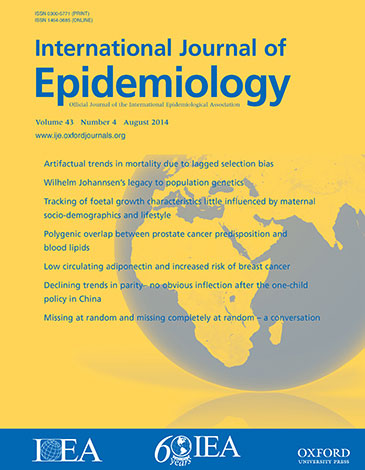Stage-standardized and stage-specific survival among men with prostate cancer in the Nordic countries 2004-16: the NORDCAN survival studies.
IF 5.9
2区 医学
Q1 PUBLIC, ENVIRONMENTAL & OCCUPATIONAL HEALTH
引用次数: 0
Abstract
BACKGROUND Prostate cancer survival varies across Nordic countries, potentially reflecting variation in stage distribution at diagnosis. To highlight the variation in the diagnostic intensity of prostate cancer, we outlined the differences in stage distributions at diagnosis across these countries. Specifically, we evaluated whether the variation in cancer survival could be attributed to differences in stage at diagnosis. METHODS In this population-based cohort study, we identified 243 893 men diagnosed with prostate cancer from 2004 to 2016 in Denmark, Iceland, Norway, and Sweden. Country-specific stage distributions at diagnosis were obtained from individual cancer registry records provided by the NORDCAN collaboration. Relative survival and 95% confidence intervals (CIs) were estimated by using the Pohar Perme estimator. Stage-standardized relative survival was estimated by applying pre-weighting based on the stage distribution of the entire Nordic cohort. RESULTS The stage distribution of prostate cancer varied between the Nordic countries, with the highest proportion of early-stage (0-I) cases in Sweden and the highest proportion of advanced-stage (IV) cases in Denmark. When adjusting for differences in stage distribution (i.e. stage standardization), the 5-year relative survival improved in Denmark and Norway within the study period (2004-17), increasing from 83.9% (95% CI, 83.2-84.6) and 91.4% (95% CI, 90.8-92.0) to 87.3 (95% CI, 86.5-88.2) and 93.4% (95% CI, 92.8-94.1). Conversely, the 5-year relative survival declined in Sweden from 90.6% (95% CI, 90.3-91.0) to 88.5% (95% CI, 88.0-89.1). CONCLUSION The distinct differences in stage distributions between the Nordic countries substantially contributed to the variation in prostate cancer survival.2004- 2016年北欧国家前列腺癌患者分期标准化和分期特异性生存率:NORDCAN生存研究
前列腺癌生存率在北欧国家各不相同,这可能反映了诊断时分期分布的差异。为了突出前列腺癌诊断强度的差异,我们概述了这些国家诊断时分期分布的差异。具体来说,我们评估了癌症生存的差异是否可以归因于诊断阶段的差异。方法在这项基于人群的队列研究中,我们在丹麦、冰岛、挪威和瑞典从2004年到2016年确定了244893名诊断为前列腺癌的男性。诊断时的国别分期分布从NORDCAN合作提供的个人癌症登记记录中获得。使用Pohar Perme估计器估计相对生存率和95%置信区间(ci)。分期标准化的相对生存率是根据整个北欧队列的分期分布应用预加权来估计的。结果北欧国家前列腺癌的分期分布存在差异,瑞典早期(0-I)病例比例最高,丹麦晚期(IV)病例比例最高。当调整分期分布的差异(即分期标准化)时,丹麦和挪威的5年相对生存率在研究期间(2004-17)得到改善,从83.9% (95% CI, 83.2-84.6)和91.4% (95% CI, 90.8-92.0)增加到87.3 (95% CI, 86.5-88.2)和93.4% (95% CI, 92.8-94.1)。相反,瑞典的5年相对生存率从90.6% (95% CI, 90.3-91.0)下降到88.5% (95% CI, 88.0-89.1)。结论北欧国家前列腺癌分期分布的显著差异是前列腺癌生存差异的重要原因。
本文章由计算机程序翻译,如有差异,请以英文原文为准。
求助全文
约1分钟内获得全文
求助全文
来源期刊

International journal of epidemiology
医学-公共卫生、环境卫生与职业卫生
CiteScore
13.60
自引率
2.60%
发文量
226
审稿时长
3 months
期刊介绍:
The International Journal of Epidemiology is a vital resource for individuals seeking to stay updated on the latest advancements and emerging trends in the field of epidemiology worldwide.
The journal fosters communication among researchers, educators, and practitioners involved in the study, teaching, and application of epidemiology pertaining to both communicable and non-communicable diseases. It also includes research on health services and medical care.
Furthermore, the journal presents new methodologies in epidemiology and statistics, catering to professionals working in social and preventive medicine. Published six times a year, the International Journal of Epidemiology provides a comprehensive platform for the analysis of data.
Overall, this journal is an indispensable tool for staying informed and connected within the dynamic realm of epidemiology.
 求助内容:
求助内容: 应助结果提醒方式:
应助结果提醒方式:


